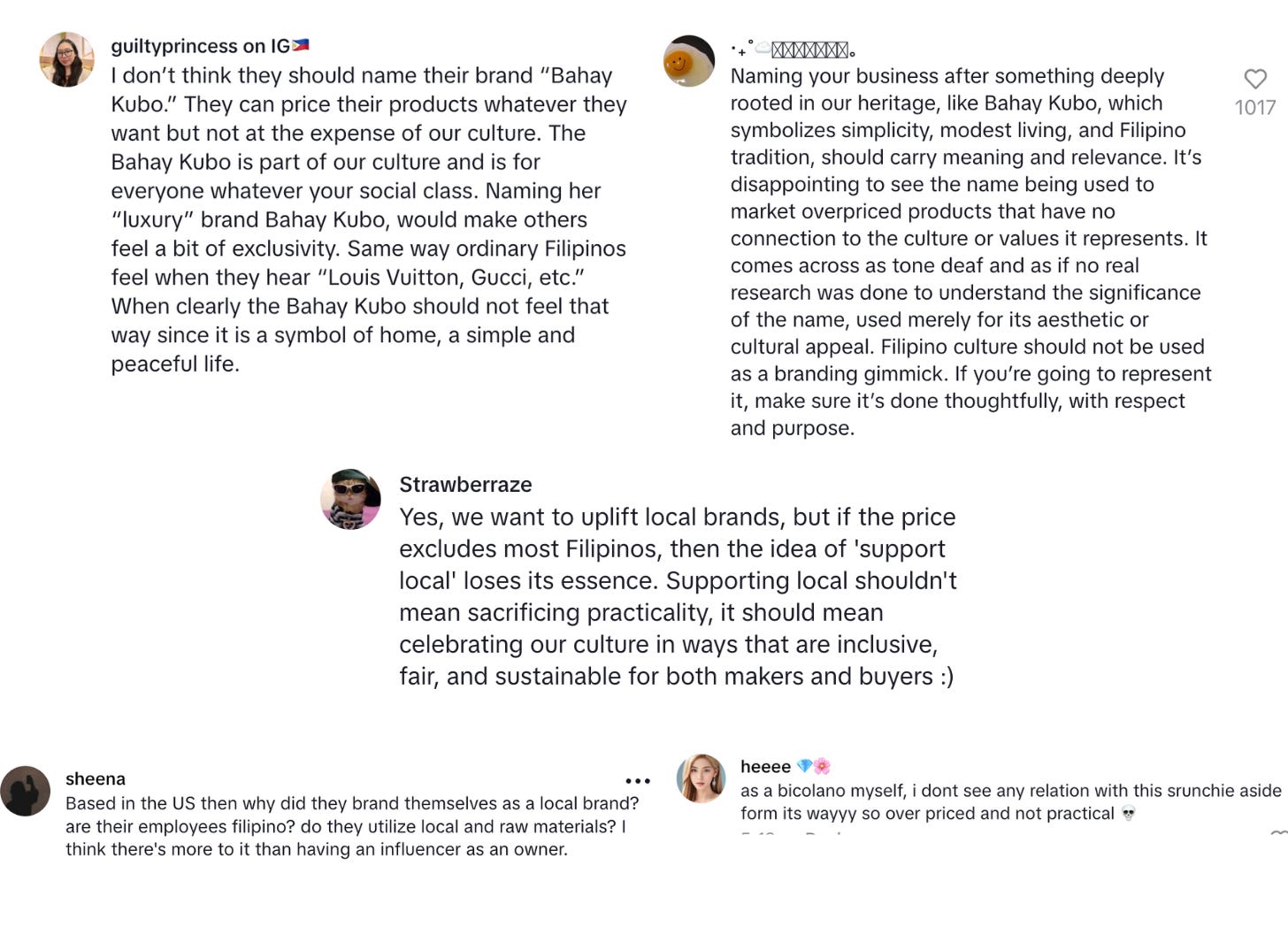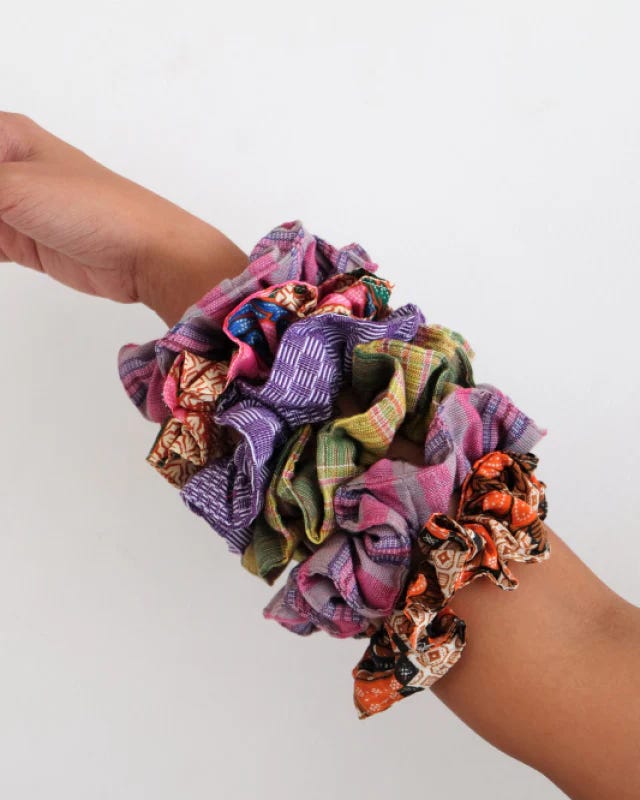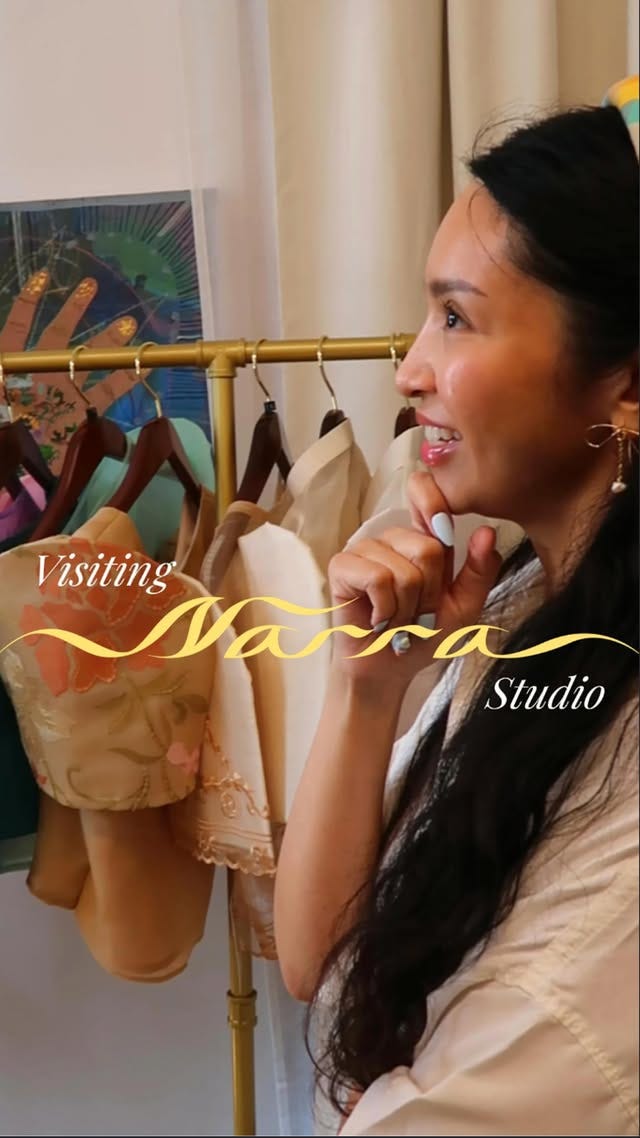Who Gets to Profit From Filipino Culture?
How a $35 silk scrunchie made me start thinking deeper about what it means to capitalize on Filipino heritage.
How much would you pay for a scrunchie?
Is ₱2,000 pesos ($35 USD) too expensive?
That pricetag–the cost of one silk scrunchie from bahay kubo–recently sparked much debate on TikTok. Launched by Filipino British model and influencer Christina Nadin in 2024, the hair accessories brand has come under fire for using Filipino culture in its name and brand marketing while listing prices inaccessible to many locals in the Philippines. Additionally, critics think the brand’s charitable efforts (donating $1 from every sale to Siargao-based grassroots NGO Lokal Lab) are insufficient compared to the product cost. A lot of the backlash comes from the brand’s name: A “bahay kubo” is a traditional hut made of local materials like bamboo and palm and symbolic of Filipino community, resilience, and simplicity. $35 silk scrunchies don’t exactly align with this ethos.
As a Filipino American closely following the bahay kubo discourse and listening to native Filipinos’ critiques, I’ve started thinking deeper about what it means to capitalize on Filipino heritage.

Countless videos from native Filipinos break down why people think this is problematic, but one from creator @jhodesaga_ articulates it best:
“If you’re going to represent local weavers, if you’re going to name your brand ‘bahay kubo,’ if you’re going to use us Pinoys to give your brand soul…number one, how are you honoring the people behind this culture? Two, how are they benefiting from this? Are we preserving culture or just packaging it? Are we really empowering the community or using their stories just to sell?”
I’m always quick to champion anything Filipino-owned, especially in the U.S. beauty industry, where there’s a dire lack of Filipino presence outside of Sunnies Face, Pili Ani, and Patrick Starr’s One/Size. I found myself interrogating that blind support when I received a jarring 1,200+ comments criticizing bahay kubo on my review posted last September. In it, I celebrated the fact that the brand is Filipino-owned and that Nadin has roots in Bicol, like me. I called the grey-colored headband named after the Mayon Volcano “meaningful.” What I failed to recognize–and what I learned from following this Scrunchie Saga–is that not all representation is created equal.
The uproar against bahay kubo is a cautionary tale that I think we need to dive into, especially as more Filipino Americans launch heritage-inspired brands. If bahay kubo had a different brand name, I don’t think there’d be nearly as much scrutiny. It’s not alone in its efforts to tie Filipino culture to a fashion or beauty product, nor is it isolated in its premium pricing. For example, Duster (a clothing brand inspired by the “loose-fitting house dress worn by Filipino women while doing housework”) sells dresses in the $185 - $285 USD price range. Mestiza (a fashion brand whose co-founders draw “inspiration from their shared Filipino heritage”) has the Merida Barong Gown, named after the traditional garment, priced at $795 USD. Kasama (originally a rum company that now sells accessories and homeware) has an abaca woven bag for $240 USD. As someone who just bought an abaca woven bag in Bicol for $9 USD, I’d bet none of these would be considered “local” prices in the Philippines. They just weren’t discovered and dragged by TikTok.
I don’t think it’s fair to expect every Filipino-founded brand to be affordable in order to be “authentic.” And, I don’t fault anyone for leaning into their culture for inspiration; in fact, I applaud it.

Being loudly, proudly Filipino, especially in the States, where white supremacy continues to influence policy and BIPOC communities are constantly under threat, can feel like an act of resistance. Being intentional about supporting Filipino-owned businesses over the Amazons of the world matters. I’m not conflating activism with shopping AT ALL, but it’s true that Filipinos find community in rallying behind each other in fashion, sports, entertainment…you name it! We are one big cheering squad. For Filipino Americans, a lot of that hunger comes from not feeling seen or represented. We find comfort in celebrating Filipino-helmed anything when you are constantly a minority. That longing for visibility might not feel as prevalent if you’re born and raised in the Philippines, surrounded by other Filipinos. DEI might not be in your everyday consciousness, especially while shopping. While native Filipinos are justified in their critiques of bahay kubo, I felt this nuance was missing, and it’s important to acknowledge for those of us in the diaspora.
If you want to position yourself as an ambassador of Filipino culture and the face of a brand that stands on Filipino tradition and values, then you need to speak to the community you claim to represent.
While I don’t know Christina Nadin personally, I think the intention to pay homage to her culture is genuine. She created bahay kubo as a tribute to her Filipino mother. The brand features models of Filipino descent like Sandra Diola and Salem Mitchell. bahay kubo has distinctly Filipino product names, like Hiraya, Sampaguita, and Buko. But, the execution falls short because there’s no synergy between the meaning of “bahay kubo” and the actual product. The disconnect is even more glaring because Nadin has not acknowledged or responded to the backlash as of this writing. She’s continued posting her skincare and makeup videos, aesthetic photos, and recaps of a brand trip with Dior. I get blocking out the haters, but this is a missed opportunity. If you want to position yourself as an ambassador of Filipino culture and the face of a brand that stands on Filipino tradition and values, then you need to speak to the community you claim to represent.
So, what does it look like when a Filipino brand embraces the culture and gives back? Allow me to introduce you to Narra Studio.
I first discovered the NYC-based brand at a screening for the MAARTE docuseries last year, and I immediately bought this terno bolero. The founder, Katte Geneta, learned traditional Filipino weaving herself and works, in her words, “directly with culture bearers, traditional artisans, and Indigenous communities throughout the Philippines.”
In addition to traditional clothing, home decor, books, and cards, they also make scrunchies (I bought this purple one). Narra Studio financially supports partner artisan communities and engages in continual donations. They’ve provided 1500lbs of rice and food to Manila families during Covid-19, offered monetary support for Typhoon Ulysses relief, and sponsored the Kiyyangan Weavers Association in Kiangan, Ifugao (read more about their impact work here). I really admire Narra Studio’s commitment to uplifting local Filipino communities.
As for the price of a Narra Studio hand-woven scrunchie?
…eight dollars!
I’d love to hear your thoughts on all of the above. What Filipino-founded brands do you think are contributing to the community meaningfully? Do you think that’s a prerequisite for creating a Filipino-owned brand? Could a Filipino-inspired brand exist without a charitable arm? Do you think it's net-positive to support all Filipino brands despite shortcomings? Do you feel like prices for a U.S. market make a Filipino product any less “authentic”? There’s a lot to unpack here, so make sure to leave a comment!









I'm constantly thinking about this, specially when it comes to fine dining and Filipino food. There's a beloved Kusina in Philly that is near and dear to my heart, but as a person who doesn't make that much money, I can't really financially support on a weekly basis lol
I hear from family members and some friends that they feel a little priced out, and there's a level of understanding their opinions but also wanting to be proud that a place exists where the food and the culture is celebrated...vs another quick carenderia type feel that most first generation Titas and Titos feel comfortable going to or opening.
Sorry if I'm rambling, as a mom of two under 5, talking and typing this much is new to me.
This is a great piece, and it opens the door to even more important questions.
At Dear Flor, we're very intentional about how we operate as a company. We believe that a humble gummy can be an ambassador for Filipino people and culture, and that belief shapes everything we do, from business decisions to product development and marketing. We don’t have a formal charitable arm, but we actively support many community and cultural organizations like FANHS, NAAFA, and House of Gongs that primarily serve Filipino Americans across the U.S. What this looks like in practice: we don’t just donate. We show up.
I did want to tackle this question: Do you feel like prices for a U.S. market make a Filipino product any less “authentic”?
I don't believe so. When we launched Dear Flor in California's licensed dispensary market, we stood by our pricing, which was on par with the market leaders, Camino and Wyld. We refused to take a haircut because doing so would only reinforce the idea that Filipino products are worth less. We stood by our pricing, and within six weeks, our gummies became one of the top three selling gummy brands in the dispensaries we entered.
That’s not an exception. It’s part of a broader trend. Filipino-owned brands like Sanzo sparkling water are positioned at a premium compared to Spindrift and other leading sparkling water brands.
Beyond Sanzo in the CPG space, you have folks like Daniel Corpuz, Kora, and Elle Karayan building unapologetically premium brands because they’re built with care, quality, and culture. Each of these brands raises the bar for how Filipino products can be valued in the U.S. market. And this is important because if we're going to create generational wealth and cultural influence for our community, we have to start demanding that our product be priced in line with the market.
Authenticity doesn’t mean undervaluing ourselves. It means knowing what we’re worth and owning it.